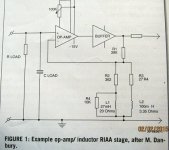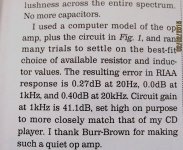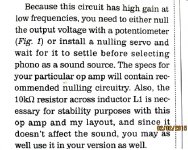Transformer Coupled Inductive Riaa.#1762
Hi Joachim
I'll build it as you designed and go on from there.I'll see if Conrad have stock.
BTW.Darcy E.Staggs has also explored an opamp LCR.No caps are used here.
Hi Joachim
I'll build it as you designed and go on from there.I'll see if Conrad have stock.
BTW.Darcy E.Staggs has also explored an opamp LCR.No caps are used here.
Attachments
Well, i always thought that everything is important.
You can not say : The loudspeaker is the most important, or the room, or the source.
One example :
I make a speaker that is the Suesskind BEO.
My rep has that speaker since the High End show in Munich.
Unfortunately he did not sell any because he thought the sound is good but not exceptional.
One day, say 4 weeks ago, he called me and said : You have to hear this !
This is awesome, this is amasing ! The bass, the soundstage, the tonal colour, the dynamics, perfect !
What had happened ?
He got a new DA converter.
Everything else in the system the same then before.
The room, the amp, the cables, everything.
Now he says : The BEOs are perfect but : garbage in, garbage out.
You can not say : The loudspeaker is the most important, or the room, or the source.
One example :
I make a speaker that is the Suesskind BEO.
My rep has that speaker since the High End show in Munich.
Unfortunately he did not sell any because he thought the sound is good but not exceptional.
One day, say 4 weeks ago, he called me and said : You have to hear this !
This is awesome, this is amasing ! The bass, the soundstage, the tonal colour, the dynamics, perfect !
What had happened ?
He got a new DA converter.
Everything else in the system the same then before.
The room, the amp, the cables, everything.
Now he says : The BEOs are perfect but : garbage in, garbage out.
BTW. Darcy E.Staggs has also explored an opamp LCR. No caps are used here.
Where did you find this one? Thanks.
The picture in http://www.diyaudio.com/forums/analogue-source/154210-mpp-1041.html#post4209548 10401 says M. Danbury, your text has Darcy E.Staggs.
Some more information would be useful.
Related topic can be found here: http://www.triodefestival.net/uploads/images_uploads/ETF13_LR_Phono_Shootout_Doc.pdf
Some more information would be useful.
Related topic can be found here: http://www.triodefestival.net/uploads/images_uploads/ETF13_LR_Phono_Shootout_Doc.pdf
Oh? I understand!
Darcy E.Staggs article credits Michhael Danbury as the originator of the design.
Here's what I have
Darcy E.Staggs article credits Michhael Danbury as the originator of the design.
Here's what I have
Attachments
So this is from AudioXpress 2-2003 written by Darcy E.Staggs .?.
Sorry I don't have this magazine.
Biggest problem with circuits like this is to get the coils. I see your
picture of the small Sowter inductors, but what about the 100mH?
Most of the time you have to wind yourself or beg somebody else
to do it and the result is not easily predictable especially if an air-
gap is required.
Sorry I don't have this magazine.
Biggest problem with circuits like this is to get the coils. I see your
picture of the small Sowter inductors, but what about the 100mH?
Most of the time you have to wind yourself or beg somebody else
to do it and the result is not easily predictable especially if an air-
gap is required.
Last edited:
Sorry for the confusion.That inductor is for JG's Inductive Riaa, post 1762.See attachment.
That ETF shootout is interesting.Did you notice how Participant1 has the second lowest score in round 2,but goes on to be the voters final choice.
And to add to this it uses OP37 and LF356.Who knew!!? Yes there's life left in those old dogs.
Thank you for that.
Are you saying that you can wind your own coils? Wow.That's a great saving.
Did you want a copy of that article? Post you a copy if you do.
That ETF shootout is interesting.Did you notice how Participant1 has the second lowest score in round 2,but goes on to be the voters final choice.
And to add to this it uses OP37 and LF356.Who knew!!? Yes there's life left in those old dogs.
Thank you for that.
Are you saying that you can wind your own coils? Wow.That's a great saving.
Did you want a copy of that article? Post you a copy if you do.
Attachments
This shootout should not be taken too serious.That ETF shootout is interesting.Did you notice how Participant1
has the second lowest score in round 2,but goes on to be the
voters final choice.
And to add to this it uses OP37 and LF356.Who knew!!? Yes
there's life left in those old dogs.
Despite the low number of 5 participants (this is due to the difficulty
of setting up the LR-RIAA amps and the general lack of suitable coils)
a clear decision could not be made, see for instance:
- winners in round n lost in round n+1:
- IV was humming in the first round only, nearly shoot out and was
among top in round 2;
- I, the final winner, had very few followers in round 1 and 2;
- III, nearly shoot out in round 1 is winner in round 2 etc.
This may in part be due to the speakers, which have not been suitable
for the task.
In other words the results of the voting are completely inconsitent,
means bs.
Yes, a copy of this article would be fine. I found nearly nothing in 2013.
So you use light to sense the position of the needle, like with a diode and a light sensitive resistor,sort of an interesting idea, 4 wires, one for led current, one common GND and two for signals. You will need a special preamp. Senseing the varying resistance
It comes with a preamp.
A guy i trust heard it and said it sounded great.
Very little noise and artifacts.
The bass was maybe a little thin but that could also be the tonearm ( his words ).
I am looking forward to hear it.
We need innovation.
A guy i trust heard it and said it sounded great.
Very little noise and artifacts.
The bass was maybe a little thin but that could also be the tonearm ( his words ).
I am looking forward to hear it.
We need innovation.
But what if you get dust somewhere in the path of the light, and what if the light beam is not uniform? And how do you get a linear transfer curve out of the beam and sensor shapes?
The bass was maybe a little thin but that could also be the tonearm ( his words ).
I am looking forward to hear it.
We need innovation.
I read about this cartridge (or the older DS-001) about 1-2 years ago, and i agree. we need innovation!
But talking about thin bass - shouldn't tonearm matter pretty much nothing with light cartridge, since it should be much more immune to resonances?
As seen from the pictures it still has a diamond and cantilever - opposed to the true optical tracking of the ELP laser disc player.But what if you get dust somewhere in the path of the light, and what if the light beam is not uniform? And how do you get a linear transfer curve out of the beam and sensor shapes?
Whether the beam is bouncing off the cantilerver or the groove itself my question is the same. How do you get a linear electromechanical light sensor and how does it deal with dust on the lenses and floating through the light beam?
Whether the beam is bouncing off the cantilerver or the groove itself my question is the same. How do you get a linear electromechanical light sensor and how does it deal with dust on the lenses and floating through the light beam?
OK I thought about that you said "shouldn't tonearm matter pretty much nothing with light cartridge" but with diamond and cantilever, suspension etc it is still a mechanical system. The optical system here is an additional complication to this.


